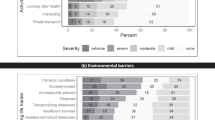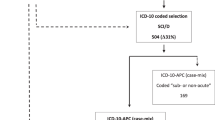Abstract
Study Design:
Retrospective analysis of acute spinal cord injuries (ASCI).
Objectives:
Determine incidence of ASCI due to suicide attempt from 1970 to 2000. Describe demographics, injuries, mental illness, functional outcomes and nature of subsequent deaths.
Setting:
State spinal cord injury services, New South Wales, Australia.
Methods:
Retrospective record review and follow-up interview.
Results:
Of 2752 ASCI admissions, 56 were because of attempted suicide (55 falls, one gun-shot wound). Thirty-six males and 20 females. Median age 30 years (15–74). Most common levels of vertebral injury were C5 and L1. Twenty-three had complete spinal cord injury. Thirty-two had an Injury Severity Score of >15. Forty had more than one major injury. There was a significant rise in the incidence of ASCI following self-harm over time (Poisson regression, P=0.004). There was a significant change in scene of injury away from hospitals over time (χ2 test, df=1, P=0.0001). Psychiatric diagnoses were personality disorder 27; schizophrenia 16; depression 14; chronic alcohol abuse 10; mood disorder 10; chronic substance abuse 10; other four. Follow-up was available in 47 cases (84%) at an average of 8 years. Four subsequent deaths were by suicide. Domiciliary arrangements were: home 28; hospital five; nursing home three; group home/hostel four.
Conclusions:
Community placement outcomes for survivors were good. Subsequent death by suicide was high. There was a significant rise in cases and a change in injury scene away from hospitals over time.
Similar content being viewed by others
Log in or create a free account to read this content
Gain free access to this article, as well as selected content from this journal and more on nature.com
or
References
Sims A, O'Brien K . Autokabalesis: an account of mentally ill people who jump from buildings. Med Sci Law 1979; 19: 195–198.
Cantor CH, Hill MA, McLachlan EK . Suicide and related behaviour from river bridges. A clinical perspective. Br J Psychiatry 1989; 155: 829–835.
Bostman OM . Suicidal attempts by jumping from heights. A three-year prospective study of patients admitted to an urban university accident department. Scand J Soc Med 1987; 15: 119–203.
Wyatt JP et al. Suicidal high falls. J Clin Foren Med 2000; 7: 1–5.
McLennan W . Suicides: Australia 1921–1998: Australian Bureau of Statistics 2000.
Newton L et al. Deinstitutionalisation for long-term mental illness: an ethnographic study. Aust NZ J Psychiatry 2000; 34: 484–490.
Babidge NC, Buhrich N, Butler T . Mortality among homeless people with schizophrenia in Sydney, Australia: a 10-year follow-up. Acta Psychiatr Scand 2001; 103: 105–110.
Degenhardt L, Hall W . The association between psychosis and problematical drug use among Australian adults: findings from the National Survey of Mental Health and Well-Being. Psychol Med 2001; 31: 659–668.
Baker SP et al. The injury severity score: a method for describing patients with multiple injuries and evaluating emergency care. J Trauma-Injury Infect Critical Care 1974; 14: 187–196.
Boyd CR, Tolson MA, Copes WS . Evaluating trauma care: the TRISS method. trauma score and the injury severity score. J Trauma-Injury Infect Critical Care 1987; 27: 370–378.
Marino RJ (ed). International Standards for Neurological Classification of Spinal Cord Injury 6th edn. American Spinal Injury Association: Chicago, IL 2000.
American-Psychiatric-Association. Diagnostic and Statistical Manual of Mental Disorders (DSM-IV) 4th edn. American Psychiatric Association Inc.: Washington, DC 1994.
Kennedy P et al. Spinal cord injuries and attempted suicide: a retrospective review. Spinal Cord 1999; 37: 847–852.
Biering-Sorensen F, Pedersen W, Muller PG . Spinal cord injury due to suicide attempts. Paraplegia 1992; 30: 139–144.
Cantor CH, Hill MA . Suicide from river bridges. Aust NZ J Psychiatry 1990; 24: 377–380.
Girard R et al. Spinal cord injury by falls: comparison between suicidal and accidental cases. Paraplegia 1980; 18: 381–385.
Hoff J, Chapman M . Vertebral fractures associated with suicide attempts. Proc Veterans Adm Spinal Cord Injury Conf 1971; 18: 53–55.
Jablensky A et al. Psychotic disorders in urban areas: an overview of the study on low prevalence disorders. Aust NZ J Psychiatry 2000; 34: 221–236.
Montross L, Zisook S, Kasckow J . Suicide among patients with schizophrenia: a consideration of risk and protective factors. Ann Clin Psychiatry 2005; 17: 173–182.
Palmer DD, Henter ID, Wyatt RJ . Do antipsychotic medications decrease the risk of suicide in patients with schizophrenia? J Clin Psychiatry 1999; 60: 100–103.
Isbister ES, Roberts JA . Autokabalesis: a study of intentional vertical deceleration injuries. Injury 1992; 23: 119–122.
Scalea T et al. An analysis of 161 falls from a height: the ‘jumper syndrome’. J Trauma 1986; 26: 706–712.
Richter D et al. Vertical deceleration injuries: a comparative study of the injury patterns of 101 patients after accidental and intentional high falls. Injury 1996; 27: 655–659.
Katz K et al. Injuries in attempted suicide by jumping from a height. Injury 1988; 19: 371–374.
Wirbel RJ et al. Treatment of severe injuries caused by attempted suicide: pattern of injury and influence of the psychiatric disorder on the postoperative course. Eur J Surg 1998; 164: 109–113.
Cantor CH, Neulinger K, De Leo D . Australian Suicide Trends 1964–1997: Youth and Beyond? Med J Aus 1999; 171: 137–141.
Burdekin B . Human rights and mental illness – report of the National Inquiry into the Human Rights of People with Mental Illness. Australian Government Publishing Service: Canberra 1993.
Maxwell JC . Update: comparison of drug use in Australia and the United States as seen in the 2001 National Household Surveys. Drug Alcohol Rev 2003; 22: 347–357.
Kavanagh DJ et al. Demographic and clinical correlates of comorbid substance use disorders in psychosis: multivariate analyses from an epidemiological sample. Schizophr Res 2004; 66: 115–124.
Hunt GE, Bergen J, Bashir M . Medication compliance and comorbid substance abuse in schizophrenia: impact on community survival 4 years after a relapse. Schizophr Res 2002; 54: 253–264.
Drake RE, Brunette MF . Complications of severe mental illness related to alcohol and other drug use disorders. In: Galanter M (ed). Recent Developments in Alcoholism. Plenum: New York 1998 pp 285–299.
Hall W, Degenhardt L, Teesson M . Cannabis use and psychotic disorders: an update. Drug Alcohol Rev 2004; 23: 433–443.
Yeo J et al. Mortality following spinal cord injury. Spinal Cord 1998; 36: 329–336.
Soden R et al. Causes of death after spinal cord injury. Spinal Cord 2000; 38: 604–610.
Gibb SJ, Beautrais AL, Fergusson DM . Mortality and further suicidal behaviour after an index suicide attempt: a 10-year study. Aust NZ J Psychiatry 2005; 39: 95–100.
Kishi Y, Robinson RG, Kosier JT . Suicidal ideation among patients with acute life-threatening physical illness: patients with stroke, traumatic brain injury, myocardial infarction and spinal cord injury. Psychosomatics 2001; 42: 382–390.
Simpson G, Tate R . Clinical features of suicide attempts after traumatic brain injury. J Nerv Ment Dis 2005; 193: 680–685.
Pentland B, Hutton LS, Jones PA . Late mortality after head injury. J Neurol Neurosurg Psychiatry 2005; 76: 395–400.
Teasdale TW, Engberg AW . Suicide after traumatic brain injury: a population study. J Neurol Neurosurg Psychiatry 2001; 71: 436–440.
Simpson G, Tate R . Suicidality after traumatic brain injury: demographic, injury and clinical correlates. Psychol Med 2002; 32: 687–697.
Glass C . Applying functional analysis to psychological rehabilitation following spinal cord injury. J Am Paraplegia Soc 1992; 15: 187–193.
Krause J . Spinal cord injury and its rehabilitation. Curr Opinion Neurol Neurosurg 1992; 5: 669–672.
Daigle MS . Suicide prevention through means restriction: assessing the risk of substitution. A critical review and synthesis. Accident Analysis Prevent 2005; 37: 625–632.
Mann JJ, Apter AB, J, Beautrais A et al. Suicide prevention strategies: A systematic review. JAMA 2005; 294: 2064–2074.
Acknowledgements
We thank the following colleagues for their assistance.
Professor Robert Cumming, Centre for Education and Research on Ageing, Concord Hospital, Concord, NSW, Australia. Professor Richard Jones, Spinal Cord Injury Unit, Prince Henry Hospital, Sydney, NSW, Australia. Dr Stella Engel, Spinal Cord Injury Unit, Prince of Wales Hospital, Sydney, NSW, Australia. Dr Susan Rutkowski, Spinal Cord Injury Unit, The Royal North Shore Hospital, NSW, Australia.
Author information
Authors and Affiliations
Rights and permissions
About this article
Cite this article
Stanford, R., Soden, R., Bartrop, R. et al. Spinal cord and related injuries after attempted suicide: psychiatric diagnosis and long-term follow-up. Spinal Cord 45, 437–443 (2007). https://doi.org/10.1038/sj.sc.3102043
Published:
Issue date:
DOI: https://doi.org/10.1038/sj.sc.3102043
Keywords
This article is cited by
-
Suicidal fall from heights trauma: difficult management and poor results
European Journal of Trauma and Emergency Surgery (2020)
-
Spinal cord injury rehabilitation and mental health, SCReaM
Spinal Cord (2017)
-
Self-harm and suicide before and after spinal cord injury: a systematic review
Spinal Cord (2017)
-
Psychological morbidity and spinal cord injury: a systematic review
Spinal Cord (2009)
-
Rehabilitation outcomes in people with pre-morbid mental health disorders following spinal cord injury
Spinal Cord (2009)



